A Compromise in Halacha – On Menachot 33a
By Eli Genauer
A common D’var Torah delivered at a wedding goes something like this: “Dear Chatan and Kallah. You are standing beneath a Chupah which is representative of the home you will build within the Jewish people. When you walk into your home, you will notice that that Mezuzah is placed in a diagonal position on the doorpost. There is a disagreement between Rashi and his grandson Rabbeinu Tam as to whether the Mezuzah should be affixed in a vertical or horizontal position. Later decisors ruled that a compromise between those two opinions was in order and therefore prescribed that the Mezuzah be affixed diagonally. This lesson of compromise is an important one as you embark upon you marriage and the Mezuzah on your door is an important reminder of this principle. Mazal Tov!”
This wedding Dvar Torah is based on a Gemara in Menachot 33a
אמר רב יהודה אמר רב, עשאה כמין נגר פסולה.
איני? והא כי אתא רב יצחק בר יוסף אמר כולהו מזוזתא דבי רבי כמין נגר הוו עביד……. ?
לא קשיא, הא דעבידא כסיכתא, הא דעבידא כאיסתוירא.
Rav Yehuda says that Rav says: If one affixes a Mezuzah like a bolt, it is invalid. Is this so? But when Rav Yitzchak bar Yosef came ( from Eretz Yisroel ) he said that all Mezuzot in the house of Rebbe ( Yehuda HaNasi) were affixed like a bolt……? This is not difficult. This ruling (where it is ruled as being unfit) is where it was prepared like a peg; that ruling (in the house of Rebbe where it is ruled as being fit) is where it is prepared like an ankle. [1]
Rashi explains that a “נגר” is something that is embedded in a wall “שתוחבין הנגרין בכותל”[2] 2. He then writes the word “כזה” and illustrates this with a drawing showing a horizontally placed Mezuzah. This is one of many times here that Rashi tells us something and then uses the word “כזה” which is then followed by a diagram. In this case, the illustration shows a horizontally affixed Mezuzah and it is a mezuzah affixed in this direction that is improper.
Rabbeinu Tam (תוס’ ד״ה “הא דעבידא כסיכתא) is bothered by the explanation of Rashi because he feels that it is more honorable to have the Mezuzah affixed in a horizontal position just as it is more honorable to have a Sefer Torah lying horizontally than standing vertically. He therefore translates the word “נגר” as a “peg” and says that the disqualification of a Mezuzah affixed כמין נגר is that it is affixed vertically, like a peg. He also translates the word כסיכתא as a peg and therefore disqualified because it is vertical, and the word איסתוירא, which is considered to be proper, as the part of the foot below the ankle which is horizontal.
The idea that affixing the Mezuzah diagonally is a compromise between the positions of Rashi and Rabbeinu Tam is based on the Shulchan Aruch, Yoreh Deah 289:6
צְרִיכָה לִהְיוֹת זְקוּפָה, אָרְכָּהּ לְאֹרֶךְ מְזוּזַת הַפֶּתַח….. הַגָּה: וְכֵן נָהֲגוּ. (בֵּית יוֹסֵף) אֲבָל יֵשׁ אוֹמְרִים שֶׁפְּסוּלָה בִּזְקוּפָה, אֶלָּא צְרִיכָה לִהְיוֹת שְׁכוּבָה, אָרְכָּהּ לְרֹחַב מְזוּזַת הַפֶּתַח (טוּר וְהַפּוֹסְקִים בְּשֵׁם רַבֵּנוּ תָּם). וְהַמְּדַקְדְּקִין, יוֹצְאִין יְדֵי שְׁנֵיהֶם, וּמַנִּיחִים אוֹתָהּ בְּשִׁפּוּעַ וּבַאֲלַכְסוֹן (טוּר וְהַגָּהוֹת מַיְמוֹנִי ומהרי”ל ות”ה סי’ נ”ב), וְכֵן רָאוּי לִנְהֹג, וְכֵן נוֹהֲגִין בִּמְדִינוֹת אֵלּוּ.
In truth, it is not really a compromise but rather an effort to affix the Mezuzah in a way in which both Rashi and Rabbeinu Tam would approve. Rashi says that vertical is the proper way, horizontal is Pasul, but bent ( or diagonal) is also Kosher. Rabbeinu Tam says that horizontal is the proper way, vertical is Pasul, but bent is also Kosher. Some Meforshim take this idea even further by saying that since in the house of Rebbe the Mezuzot were affixed כאיסתוירא, this was some sort of Hidur and therefore something to be emulated.
The classic edition of the Vilna Shas (Vilna 1885) renders this Sugya and the accompanying diagrams as such
Here are the words of Rashi which correspond to these two diagrams which show the positioning of four Mezuzot
-
עשאה כמין נגר – שקבעה ותחבה בסף כנגר, שתוחבין הנגרין בכותל כזה.
-
פסולה – דמצותה לתתה באורך בסף כזה …. נגר, קביליא
-
עבידא כסיכתא – נגר כשל אומנים כזה פסולה
-
איסתוירא – היינו מקום חיבור השוק והרגל ומעומד הוא כזה, כשירה:
-
ל”א איסתוירא, כי היכי דמקום חיבור השוק והרגל הוי השוק זקוף מלמעלה והרגל שוכב כזה כך הניחה למזוזה כשירה הואיל וראשה אחד זקוף:
The doorframe in the top illustration shows the position of two Mezuzot.
The one on top is horizontal which is improper, and the one on the bottom is vertical which is Kosher.
-
עשאה כמין נגר – שקבעה ותחבה בסף כנגר, שתוחבין הנגרין בכותל כזה.
He affixed and inserted it in the doorpost like a bolt, for workmen who work with bolts insert it in the walls like this[3]
-
פסולה – דמצותה לתתה באורך בסף כזה ….
It is improper- Because the Mitzvah is to affix it vertically in the doorpost like this….
The doorframe in the lower illustration also shows two Mezuzot.
The one on top is horizontal and therefore improper and the one on the bottom is bent (it looks like the Hebrew letter Nun), and therefore Kosher. Here are the words of Rashi which correspond to these two Mezuzot.
עבידא כסיכתא – נגר כשל אומנים כזה פסולה
A bolt as fashioned by workmen like this is disqualified
ל”א איסתוירא. כי היכי דמקום חיבור השוק והרגל הוי השוק זקוף מלמעלה והרגל שוכב כזה כך הניחה למזוזה כשירה הואיל וראשה אחד זקוף
Another explanation of איסתוירא – like the point at which the “Shok” joins the ”Regel”, where the “Shok” is upright and the “Regel” rests, like this, so too if he affixes the Mezuzah like this it is Kosher because the top part is upright.
There is no diagram associated directly with this comment of Rashi
איסתוירא – היינו מקום חיבור השוק והרגל ומעומד הוא כזה, כשירה:
Whether a נגר is normally inserted horizontally or vertically is also “illustrated” in Jastrow’s explanation of the word
In Bava Batra 101a he describes it “like an upright bolt” and in our Gemara he describes it as “like a bolt shoved into a case, i.e. horizontally”
There are two issues with the standard depiction of the two diagrams in the Vilna Shas. Rashi uses the word כזה five times and there are only four “illustrations” (2 in each diagram) Also, we would expect that there would be a diagram after each time it says כזה.
This problem is solved when we look at the only handwritten manuscript we have of Rashi on this part of Menachot.
The National Library of Russia, St. Petersburg, Russia Ms. EVR IV 25:
It contains five depictions of the placement of the Mezuzot and each כזה is followed by a depiction.
The problem is also solved when we look at the first printed edition of Menachot ( Bomberg 1522) whose source had to be a manuscript. [4]
This printed edition leaves space after every כזה. It even includes a rudimentary depiction of the last כזה looking like a “Nun” which is supposed to depict where the ankle meets the leg.
It looks very much like the Nun in the National Library of Russia manuscript and may have emanated from the same source.
It was very exciting for me personally to discover this “diagram” which clearly was added to illustrate the כזה. In his Maamar ‘al hadpasat ha-Talmud with Additions, (ed. A.M. Habermann, Mossad ha-Rav Kook, Jerusalem: 2006, p.41) Rav Natan Nata Rabbinowicz, writing about the first Bomberg edition, states as follows:
״ובכל התלמוד (וכן בכל הדפוסים הישנים עד דפוס בערמן) נשמטו הציורים בגמרא, רש״י ותוספות,ונשאר מקומם חלק, מלבד בסוטה מג. שישנו הציור ברש״י
“In all of the Talmud (and in all other older printed editions of the Talmud until the Berman edition ( Frankfurt an Der Oder 1697-99) the diagrams were not included in the Talmud, Rashi and Tosfot, and their space remained empty, except for Sotah 43A, where we find a diagram in Rashi.”
It turns out there was a diagram included in the second Bomberg edition of Zevachim( 1528) on 53b, which Rabbinowicz probably never saw. See my article
here.
He may have also missed this one because it does not look much like a diagram, but just a letter, or perhaps he felt it was of no significance.
This depiction of the last כזה looking like a “Nun” was maintained by subsequent editions of the Talmud printed in Basel 1580, Cracow 1605, Amsterdam 1644, and Frankfurt an der Oder in 1699.
It was only dropped and replaced with the two larger diagrams we have today in the Frankfurt am Main edition of 1720.
Since many people follow the advice of the Rema and affix the Mezuzah diagonally, it is important to understand the source. This is the word in the Gemara which state that in the house of Rebbe, the Mezuzot were affixed כאיסתוירא. This word is etymologically related to the Latin word astragalus which is described as “the bone in the ankle that articulates with the leg bones to form the ankle joint”. It is more commonly known today as the Talus and looks like this:[5]
As used in the Gemara, it probably meant the entire area where the bottom of the foot ( which is horizontal) met the bottom of the leg ( which is vertical) at the ankle, thereby looking like something that was bent.
Finally, there is a fascinating story about the Talus bone related by Rav Yisroel Shachor in the
Sefer “Dovair Yesharim”.[6] In discussing the איסתוירא, he writes that he was in a terrible automobile accident and בחסדי ה׳ escaped death by climbing out of the rear of the car only seconds before it burst into flames. The only injury he sustained was a broken bone in his foot, which he identified as the Talus. He had many opportunities to view x-rays of his broken foot and concludes “I see this as a source of amazement that the only bone of all 248 bones in my body which was broken, allowed me to understand the words of Torah, and to understand that this was the איסתוירא which is mentioned in Gemarot.”[7]
[1] Translation courtesy of Sefaria.org and follows the interpretation of Rashi.
[2] There is discussion on whether what is shown as Rashi in our editions of Menachot was actually written by Rashi. Rav Natan Nata Rabbinowicz ( author of Dikdukei Sofrim) writes that our “Rashi” was written by a student of Rabbeinu Gershom. ( Dikdukei Sofrim on Menachot 86a note 6 where he writes …מפני שהפרוש הזה המיוחס לרש״י הוא כנראה מתלמיד הרבינו גרשום מאור הגולה והעתיק ברובו לשון הרבינו גרשום מאור הגולה) Rav Betzalel Ashkenazi (the author of the Shita Mekubetzet) writes that for chapters 7-10, the “Rashi” in the standard editions was not written by Rashi and he substitutes his own version which is indicated by the words “Rashi Ktiv Yad” in the Vilna Shas. The editors of the Vilna Shas record this opinion at the beginning of the 7th chapter ( Menachot 72a) as follows: וזה לשונו “זה הפּרוש אשר הוא בדפוס מפרק אלו המנחות עד שתי הלחם אינו מפי׳ רש״י ז״ל והוא של פרשן אחר, וזה לשון רש״י כּ״י”.But Rav Ashkenazi seems to indicate that the Rashi of other chapters was in fact written by Rashi. ( see his note to the beginning of Menachot chapter 11 where he writes מכאן ואליך הוא פירוש רש״י ז״ל).
[3] We only know that it is affixed in a horizontal direction from the picture, not from Rashi’s words.
[4] The Soncino family printed many tractates of the Talmud from 1483-1519 before Bomberg printed the complete Talmud in 1520-1522, and those Soncino editions often formed the basis for the text of the Bomberg edition. But the Soncino family did not print tractate Menachot meaning the Bomberg edition was based solely on manuscripts.
[5] My source for this information is Dr. Carol Teitz who is a member of my Shul. Dr. Teitz is an orthopedic surgeon and most recently, the dean of admissions at the University of Washington Medical School
[6] Doveir Yesharim, Sefer Shemot, Jerusalem. 2014, page 128
[7] This source was brought to my attention by a Torah scholar named Aharon who has helped me immensely in my research on diagrams.
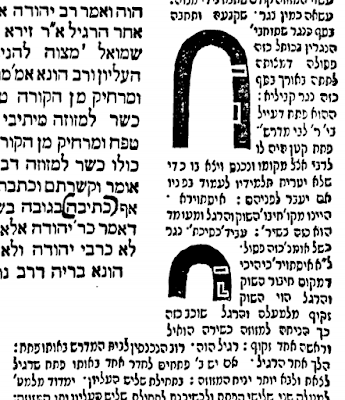


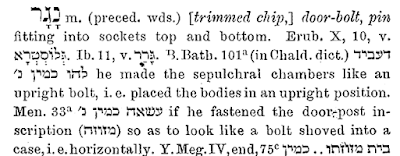
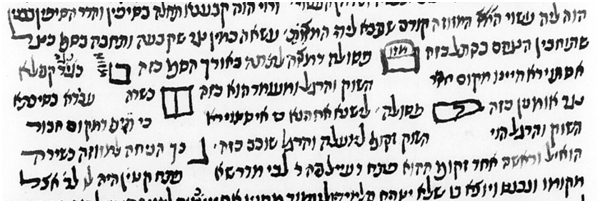
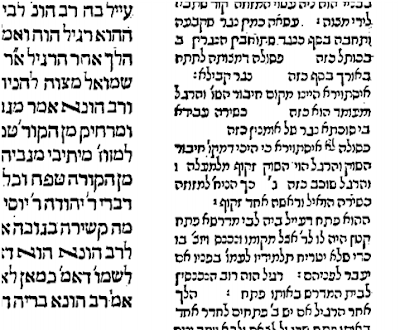

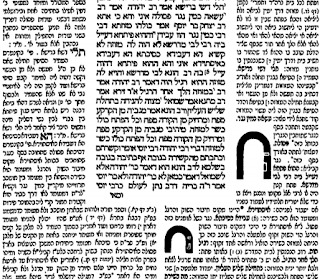
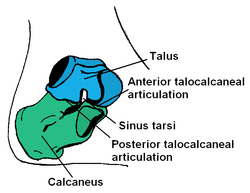



22 thoughts on “A Compromise in Halacha – On Menachot 33a”
I simply want to tell you that I am very new to blogging and really enjoyed this web site. More than likely I’m want to bookmark your blog . You definitely come with tremendous well written articles. Many thanks for sharing your web-site.
After study several of the blog posts on your internet site now, we really such as your method of blogging. I bookmarked it to my bookmark web site list and are checking back soon. Pls look at my web site likewise and told me how you feel.
When I originally commented I clicked the -Notify me when new comments are added- checkbox now when a comment is added I buy four emails with the same comment. Possibly there is that is it is possible to get rid of me from that service? Thanks!
site : https://www.wooricasinokorea.com/casinosite 카지노사이트
A fascinating discussion is worth comment. I do think that you should publish more on this subject matter, it may not be a taboo matter but generally people don’t talk about these topics. To the next! All the best.
It’s hard to find educated people about this subject, but you seem like you know what you’re talking about! Thanks
more https://www.wooricasinokorea.com 바카라
Saved as a favorite, I love your site!
An additional issue is that video games are generally serious naturally with the main focus on mastering rather than leisure. Although, we have an entertainment element to keep children engaged, each one game is often designed to work with a specific experience or area, such as mathematics or technology. Thanks for your post.
Do you believe past life regression? Do you think is reincarnation real?
I could not refrain from commenting. Exceptionally well written!
visit my homepage https://www.wooricasinokorea.com/sandscasino 샌즈카지노
You made some good points there. I looked on the net to find out more about the issue and found most individuals will go along with your views on this website.
This site was… how do you say it? Relevant!! Finally I have found something that helped me. Kudos.
Hello there! This article could not be written any better! Reading through this article reminds me of my previous roommate! He continually kept preaching about this. I most certainly will send this article to him. Fairly certain he’ll have a very good read. Thank you for sharing!
Pretty! This has been a really wonderful article. Thank you for supplying this information.
I don’t know about the listicles.. seems somewhat redundant.
win money bingo
Sharing this with colleagues.
Good on you for sharing.
https://infinitecbd.com/cbd-isolate/
I specifically like CBD Isolate products because they do not contain any THC so I have peace of mind in the case that I have to take a drug test for work because I work for Border Patrol.
I want to to thank you for this fantastic read!! I absolutely enjoyed every bit of it. I have got you book-marked to check out new stuff you post…